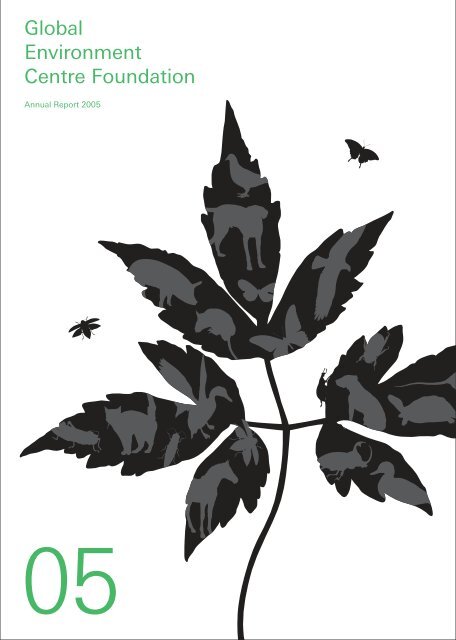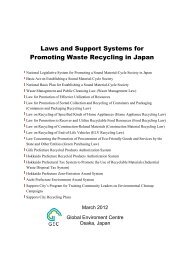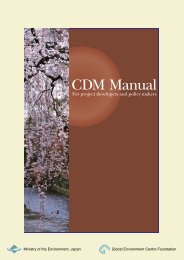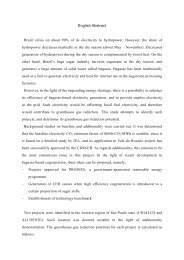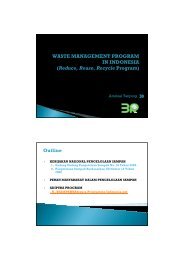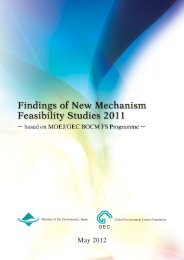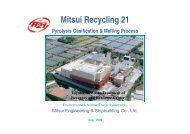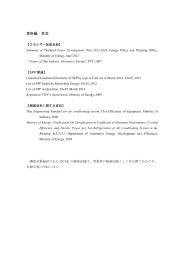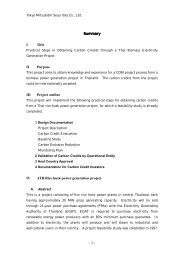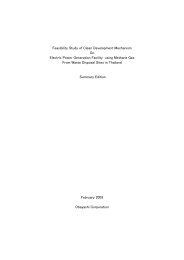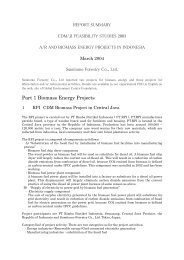PDF Version (1.2MB) - Global Environment Centre Foundation (GEC)
PDF Version (1.2MB) - Global Environment Centre Foundation (GEC)
PDF Version (1.2MB) - Global Environment Centre Foundation (GEC)
Create successful ePaper yourself
Turn your PDF publications into a flip-book with our unique Google optimized e-Paper software.
<strong>Global</strong><strong>Environment</strong><strong>Centre</strong> <strong>Foundation</strong>Annual Report 200505
contents1 Foreword2 Overview of the <strong>Global</strong> <strong>Environment</strong> <strong>Centre</strong> <strong>Foundation</strong>4 Activities in Fiscal Year 2005 • International Cooperation: Technical Support for Developing Countries • Training of <strong>Environment</strong>al Technology • PR and Educational Activities • Provision of Facilities to UNEP DTIE IETC16 Projects for Fiscal Year 200618 References • Overview of the UNEP DTIE IETC • Board Members of the <strong>Global</strong> <strong>Environment</strong> <strong>Centre</strong> <strong>Foundation</strong> • Publications List
ForewordIt would be fair to say that global environment presents one of the biggest challenges tothe survival of mankind in the 21st century. <strong>Global</strong> warming in particular has been labeledas the cause for the recent abnormal weather typified by massive hurricanes, and it willrequire all of our wisdom to formulate measures to deal with it.Based on the United Nations Framework Convention on Climate Change, whose ultimategoal is to stabilize the atmospheric level of greenhouse gases bringing about globalwarming, the Kyoto Protocol finally came into force in February 2005 making the reductionof greenhouse gas emissions mandatory for developed nations. However, the withdrawalfrom the Protocol of some developed nations including the United States and the increasein emissions by developing nations not compelled to make reductions means that there stillremain many issues to be addressed.Amidst this backdrop, the <strong>Global</strong> <strong>Environment</strong> <strong>Centre</strong> <strong>Foundation</strong> (<strong>GEC</strong>) was establishedin 1992 as a support body for the United Nations <strong>Environment</strong> Programme (UNEP)International <strong>Environment</strong>al Technology <strong>Centre</strong> (IETC), since which time we have made thetransfer of <strong>Environment</strong>ally Sound Technologies the focus of our activities in order to helprealize environmental conservation and sustainable development in developing nations.In 2005, <strong>GEC</strong> implemented the CDM (Clean Development Mechanism)/JI (JointImplementation) Feasibility Study Programme at the commission of the Ministry of the<strong>Environment</strong>, Japan in order to promote global warming countermeasures and lead tosustainable development. Furthermore, in addition to accepting the Japan InternationalCooperation Agency’s (JICA) commission to train environmental policymakers and otherpersonnel from developing nations, <strong>GEC</strong> has been actively tackling environmental issuessuch as the implementation of Eco-town projects with IETC in order to transfer Japan’sEco-town concept to cities in developing nations.<strong>GEC</strong> will continue to promote such initiatives in the future and will contribute tointernational cooperation relating to the environment while cooperating with our affiliatedorganizations, in addition to striving even harder towards the conservation of the globalenvironment.It is our hope that, through this annual report, we are able to foster an understanding of<strong>GEC</strong>’s activities, and that we may look forward to your continued support and cooperationin the future.January 2007KUMAGAI, NobuakiPresident<strong>Global</strong> <strong>Environment</strong> <strong>Centre</strong> <strong>Foundation</strong><strong>GEC</strong> 2005 1
Overview of the <strong>Global</strong> <strong>Environment</strong> <strong>Centre</strong> <strong>Foundation</strong>Background of the EstablishmentEstablishment of the UNEP DTIE International <strong>Environment</strong>al Technology <strong>Centre</strong>In the 1960s, in conjunction with rapid industrialization, the city of Osaka suffered fromseveral unprecedented environmental problems. Enormous infrastructure improvementsand development of environmental technologies were subsequently achieved throughcooperation between the municipal government and industry. In the hope of extending thesebenefits beyond its borders, the Osaka City Government has been working to help alleviateenvironmental problems in developing countries.With this in mind, in August 1989, Mr. Masaya Nishio, Mayor of Osaka, announced a planto attract an international environmental organization to the city in order to disseminate andapply Osaka’s successful experience in its urban environmental management. This plan wasannounced in accordance with the spirit of the International Garden and Greenery Expositionheld in Osaka in 1990. Following the mayor’s announcement and with the support of theJapanese national government, the Osaka Prefectural Government, and business organizationsin the region, Osaka Mayor Nishio officially handed a request to Dr. Mostafa K. Tolba, thenExecutive Director of the United Nations <strong>Environment</strong> Programme (UNEP), while he wasvisiting Japan.The result was that, in July 1990, at a summit of developed nations in Houston, USA,Prime Minister Toshiki Kaifu announced the plan of setting the UNEP facilities up in Japan.In August of the same year, Mr. Naohiro Kumagai, then Japan’s Ambassador to Kenya,proposed to the 2nd Special Meeting of the UNEP Governing Council that a center be set upin Japan in view of the increasing importance of environmental technology transfer to achievesustainable development. In May of the following year, a resolution to establish the UNEPDTIE International <strong>Environment</strong>al Technology <strong>Centre</strong> (IETC) whose mandate is the adoption,application and operation of <strong>Environment</strong>ally Sound Technologies (ESTs) in developingcountries and countries with economies in transition, was unanimously approved at the 16thSession of the UNEP Governing Council. Official establishment of IETC was completed inOctober 1992 in Osaka when UNEP Executive Director Tolba and Parliamentary Vice-Ministerfor Foreign Affairs Kakizawa signed an official agreement marking the founding of IETC. Since1998, IETC has operated as a part of UNEP’s Division of Technology, Industry and EconomicsDivision (DTIE).Note: all titles are effective as of the years mentioned here.Establishment of the <strong>Global</strong> <strong>Environment</strong> <strong>Centre</strong> <strong>Foundation</strong>After official approval in 1991 by the UNEP Governing Council to set up the IETC in Japan,the Osaka City Government formed an UNEP IETC Osaka Planning Office on July 3, 1991.The purpose of the office was to carry out planning and create a network of support for theproposed center. Following initial preparation by the Planning Office, capital endowment wasreceived from the Osaka prefectural and city governments. The establishment of the <strong>Global</strong><strong>Environment</strong> <strong>Centre</strong> <strong>Foundation</strong> (<strong>GEC</strong>) was carried out on January 28, 1992 with the expressedpurpose of supporting IETC. <strong>GEC</strong>, a nonprofit organization, obtains support from the localbusiness sector.<strong>GEC</strong> provides logistical support to IETC Osaka and collaborates with IETC on joint projects.It also acts as a liaison between environmental organizations in Japan and the IETC. In thisway, it helps to ensure the IETC’s smooth and efficient operation. In addition, <strong>GEC</strong> promotesenvironmental conservation through original projects such as the collection and disseminationof environmental technological information, training programs, seminars and symposia, as wellas research.Thus, in all of these ways, <strong>GEC</strong>’s activities make a significant international contribution byJapan in the environmental field.2 <strong>GEC</strong> 2005
Mission and Objectives<strong>GEC</strong> was established to make use of the abundant accumulation of knowledge andexperience in Japan in the field of environmental conservation. In particular, it makes use ofknowledgeable groups and individuals in the Kansai region in order to support contributionsof IETC in the field of urban environmental management in developing countries. Thus, <strong>GEC</strong>promotes international cooperation around environmental conservation, and aims to makemeaningful, practical contributions to the protection of the global environment.Name<strong>Global</strong> <strong>Environment</strong> <strong>Centre</strong> <strong>Foundation</strong> (<strong>GEC</strong>)Date of Establishment January 28, 1992Supervisory Authorities The Ministry of Foreign Affairs of JapanThe Ministry of the <strong>Environment</strong> of JapanOffice Location 2-110 Ryokuchi-koen, Tsurumi-ku, Osaka 538-0036 JapanTelephone: +81-6-6915-4121Facsimile: +81-6-6915-0181Endowments 1,748,610,000 yen (as of March 31, 2006)Activities(1) Providing general support for activities of UNEP relating to urbanenvironmental conservation in developing countries(2) Undertaking research which contributes to the conservation of the globalenvironment, with particular emphasis upon urban environmentalmanagement in developing countries(3) Collection and dissemination of information which contributes to theconservation of the global environment, with particular emphasis upon urbanenvironmental management in developing countries(4) Conducting of training programs, seminars, and symposia which contributeto conservation of the global environment, with particular focus upon urbanenvironmental management in developing countries(5) Facilitating communications with international organizations, governmentalorganizations, and research organizations in various countries, in order tocontribute to conservation of the global environment(6) Any other activities necessary to achieve the mission of <strong>GEC</strong>Number of Staff 16 (as of August 1, 2006)<strong>GEC</strong> 2005 3
Activities in Fiscal Year 2005In order to promote UNEP DTIE IETC’s activities of spreading informationon <strong>Environment</strong>ally Sound Technologies (ESTs) and technology transfer,<strong>GEC</strong> collaborated with IETC and other related organizations to carry outneeds surveys to establish Eco-towns in cities throughout Asia. <strong>GEC</strong> thenapplied the survey results to co-host an open session entitled “ThematicSession on <strong>Environment</strong>ally Sustainable Industrial Development andthe Concept of Eco-Towns in the Asia Pacific Region” with IETC, APOand CITYNET at the “Eco-Products International Fair 2005” in Bangkok,Thailand.In an ongoing process to overhaul our environmental technology database“NETT 21”, <strong>GEC</strong> updated the “Waste Treatment Technology in Japan”database in 2005.As a part of our international cooperation within developing nations,<strong>GEC</strong> also conducted a field survey with the help of a support team anddrafted an environmental map in order to bolster the environmentalactivities of local residents of Thailand’s Tha Chin River basin.In terms of our contribution to combating global warming, <strong>GEC</strong> continuedefforts in 2005 to unearth promising projects and accumulate knowledgefor the CDM (Clean Development Mechanism) and JI (Joint Implementation)in our role as secretariat of the CDM/JI Feasibility Study Programmecommissioned by the Ministry of the <strong>Environment</strong>, Japan. <strong>GEC</strong> providedinformation acquired through participation in the CDM Executive Boardand the JI Supervisory Committee on our website, and presented exhibitionbooths at COP11 and COP/MOP1 held in Montreal, Canada.Carrying on from 2004, <strong>GEC</strong> offered five JICA training courses to trainpersonnel from developing nations. <strong>GEC</strong> also expanded the contentavailable on the “JICA-<strong>GEC</strong> Network” and conducted surveys on the use ofknowledge and experience acquired by former training course participantsupon return to their countries with the aim of following up on their progressand better understanding the needs of developing nations.<strong>GEC</strong> worked to spread awareness of <strong>Environment</strong>al ManagementSystems (EMS) by conducting the “Internal <strong>Environment</strong>al Auditor TrainingCourse”.In August through September 2005, UNEP Special Envoy Ms. Tokiko Katovisited areas in Thailand and Sri Lanka affected by the Indian Ocean tsunami.In October, <strong>GEC</strong> worked to promote an awareness and understanding ofour projects by hosting a side event entitled “<strong>Global</strong> Warming Seminar” aswell as presenting a booth exhibit at the “New Earth 2005” symposium.4 <strong>GEC</strong> 2005
Activities in Fiscal Year 2005International Cooperation: Technical Support for Developing CountriesPromoting UNEP DTIE IETC’s Activities of Disseminating Information on<strong>Environment</strong>ally Sound Technologies (ESTs*) and Technology TransferESTs<strong>Environment</strong>ally SoundTechnologies, as definedin Agenda 21, shouldprotect the environment,are less contaminative,use various resources in amore sustainable manner,recycle more of their wastesand products and handleresidual waste in a moreacceptable manner than thetechnologies for which theywere substitutes.Eco-TownThe Eco-Towns developedin Japan utilize a frameworkwhereby environmentallysoundenterprises are built onaccumulated land using localtechnologies and industries,thereby stimulating thelocal economy and ensuringemployment as well assimultaneously achievingwaste management andconservation of water and airquality.“Thematic Sessionon <strong>Environment</strong>allySustainable IndustrialDevelopment and theConcept of Eco-Towns inthe Asia Pacific Region”Participants: Approx. 100Participating Cities: 8BiomassBiomass is organic matterproduced by living organismsthrough the photosynthesisof water and carbon dioxideusing light from the sun. Thecarbon contained in biomassis ingested in the livingorganism’s growth processso even if combusted, theamount of carbon dioxidein the atmosphere does notincrease.Zero EmissionA concept which aims toestablish a “zero waste”production system usingrefuse from manufacturingprocesses as recoverableresources for industry (ISOterminology dictionary).Report on Eco-Towns* in JapanAlthough IETC has previously been involved in waste management measures, it is nowalso working on a new project to apply eco-town concept based on knowledge and similarexperiences from Japan to developing nations, where there is a need for environmentallyfriendlyindustrialization and industrial development.To that end, <strong>GEC</strong> carried out a survey in 2004 with IETC targeting eco-towns in KawasakiCity in Kanagawa Prefecture, Minamata City in Kumamoto Prefecture and Naoshima Town inKagawa Prefecture. The survey looked at eco-town formation in Japan and its management,the role of affiliated organizations, their challenges and the relationship with “the 3Rs” and thecreation of a recycling society.A similar survey on the eco-town in Kitakyushu City in Fukuoka Prefecture was also carriedout in 2005, the results of which were combined with the 2004 survey to draft the documententitled “Eco-Towns in Japan” for use in eco-town initiatives in developing countries.This document has made a significant contribution to launching IETC projects ondevelopment of Eco-Towns in the Asia Pacific Region.Hosting of the “Thematic Session on <strong>Environment</strong>ally Sustainable IndustrialDevelopment and the Concept of Eco-Towns in the Asia Pacific Region*”In the Asian region where economic development ismoving ahead, there is growing interest in the conceptof eco-towns as a means of achieving a balance betweenthe environment and the economy, and IETC hascommenced eco-town projects in the region based onthe lessons learned from Japan’s own experiences in thedevelopment of eco-towns.Eco-Town SessionIn association with this work, <strong>GEC</strong> has carried outa needs survey to set up eco-towns in Asian municipalities in cooperation with CITYNET.With the participation of the eight cities selected as a result of the survey, <strong>GEC</strong> co-hosted theabove entitled session with IETC, CITYNET and APO introducing knowledge and experiencegained from Japan’s eco-towns and held a discussion on eco-town development in developingnations in the Asia Pacific region. <strong>GEC</strong> plans to draft a training manual for use in theselocalities and to promote eco-town projects in the future.“Thematic Session on <strong>Environment</strong>ally Sustainable Industrial Developmentand the Concept of Eco-Towns in the Asia Pacific Region”Date October 8, 2005VenueBangkok, ThailandOrganizers UNEP DTIE IETC, <strong>GEC</strong>, CITYNET, Asian Productivity Organization(APO)Participating San Fernande(Philippines), Sri Jayawardhanapura Kotte(Sri Lanka), Colombo(Sri Lanka),Cities (8 cities) Hue(Vietnam), Visakhapatnam(India), Bandung(Indonesia), Palembang(Indonesia), Penang(Malaysia)Programme • Presentation“Biomass* and Zero Emissions* in the Context of Eco Town Development”Mr. Masatoshi Yoda, Corporate Adviser of Ebara Corporation, Japan“Establishing Eco-Towns: Experience from APO’s Projects”Mr. Augustine Koh, Director, <strong>Environment</strong> Department, APO“The Eco-Towns Initiative in Japan: Implications for Cities in the Asia Pacific Region”Mr. Yuichi Nagasaka, Director, <strong>GEC</strong>“The Criticality of Eco-Towns for <strong>Environment</strong>ally Friendly Industrial Development in Asian Cities”Ms. Khunying Nathanon Thavisin, Bangkok Metropolitan Administration(BMA)• Panel DiscussionTheme: Strategies and Guidelines to adopt Eco-Towns in Cities in Asia-Pacific6 <strong>GEC</strong> 2005
Promoting the Spread of Information on ESTs<strong>GEC</strong>’s environmental technology database “NETT21*”is currently comprised of technical databases coveringten fields and is accessible to the public via <strong>GEC</strong>’swebsite. In 2005, we updated the “Waste TreatmentTechnology” database which was first published nineyears ago. In updating the database, an expert committeewas established and the following changes were madeto enable users to access information on Japan’s latestwaste treatment technology more efficiently and moreeasily: 1) the adoption of an integrated, common format2) the classification of waste by category (combustiblewaste, sludge etc.) and 3) the option to search thedatabase by technology or company name.We also plan to consecutively update other databases.<strong>Environment</strong>al Technology Database“NETT21”NETT21(New <strong>Environment</strong>alTechnology Transfer inthe 21st Century)A database developed by<strong>GEC</strong> from 1996 onward todisseminate informationon Japan’s environmentaltechnologies for the purposeof promoting EST transfer indeveloping countries.NETT21 currently offersapproximately 1,500 items oftechnical information acrossten databases.Please refer to page 20 fordatabase entries.Urban Water Issues• Booklet on “Water and Wastewater Reuse” andWebsite on Wastewater Treatment (GESAP)<strong>GEC</strong> has collaborated with IETC since 2003 to publisha booklet on water and wastewater reuse which targetspolicymakers in developing countries. This booklet wasjointly issued in 2005 and distributed at “The 4th WorldWater Forum” held in Mexico in March 2006.With the ever-increasing demand for water broughtabout by rapid population increases in developingnations, it is essential to effectively use limitedwater resources by reusing wastewater for variousapplications. It is also necessary to place limitations onthe applications of wastewater reuse and to sterilize itin order to minimize the risk of waterborne infectiousdiseases. In addition to providing a description of thesewastewater reuse policies and guidelines, the bookletintroduces examples of wastewater used for agriculture,industry and even drinking water in countries around theworld.In 2005, <strong>GEC</strong> launched the <strong>GEC</strong> Sanitation Programme(GESAP) website on wastewater treatment includingsewerage. The website currently consists of sectionsentitled “<strong>Global</strong> Situation in Sanitation Sector”, “Waterand Wastewater Reuse” and “Sewerage Works inOsaka, Japan” and an initial draft of new content entitled“Resource and Energy Recovery in Sanitation” has alsobeen completed.“Water andWastewaterReuse”Booklet<strong>GEC</strong> Sanitation Programme (GESAP)Website<strong>GEC</strong> 2005 7
Activities in Fiscal Year 2005International Cooperation: Technical Support for Developing CountriesUNEP Project on Supportfor <strong>Environment</strong>alManagement of the IraqiMarshlandsPlease refer to the IETCwebsite for details.Condition of the WetlandsThe Iraqi Marshlands wereonce the largest wetlandregion in the MiddleEast renowned for theirindigenous ecologicalsystems and biodiversity.However, dam constructionand irrigation from the upperbasins of the Tigris andEuphrates Rivers togetherwith drainage projects underthe former regime have ledto a dramatic reduction intheir size and have dealt asevere blow not only to theecosystem but local fishingand agricultural industries aswell. The Iraqi Marshland ©UNEP• Support for the UNEP Project on Support for <strong>Environment</strong>al Management ofthe Iraqi Marshlands*Since August 2004, IETC has been carrying out the “Support for <strong>Environment</strong>alManagement of the Iraqi Marshlands” project. Within the framework of this project, followingthe “Sustainable Sanitation Training Course” in 2004, <strong>GEC</strong> has also been commissioned tocarry out the “Training Course on ESTs for Drinking Water Provision” and the “Study Tourfor Iraqi Officials”. This specifically involves the creation of a training program, selection oflecturers, drafting of a training text and arranging accommodation and other services for theparticipants.As a related project, both IETC and <strong>GEC</strong> cooperated in the training for “Restoration ofMarshlands in Southern Iraq” conducted by JICA in March 2006 by providing lectures and fieldtrips for the 13 Iraqi participants. The lecture began with an introduction of IETC and <strong>GEC</strong>’sprojects followed by an inspection of small-scale and large-scale “johkasou” household wastewater treatment systems in Osaka Prefecture with the cooperation of Osaka Prefecture, ToyonoTown and the Yamatedai Wastewater Treatment Plant Management Association in Ibaraki City.Outline of the “Training Course on ESTs for Drinking Water Provision”Operating Body UNEP DTIE IETCCommissioned Body <strong>GEC</strong>Associated Bodies Waterworks Bureau of Osaka Municipal Government,Osaka City Waterworks Service Association,Maibara Municipal Government, Lake Biwa-Yodo RiverWater Quality Preservation Organization,<strong>Foundation</strong> for Advanced Studies on InternationalDevelopment(FASID), Japan International CooperationAgency Osaka International Center(JICA OSIC),Field trip to small waterworksJapan International Cooperation Center(JICE)facility using the reverse osmosisTraining Period May 16-27, 2005process in Maibara CityParticipants30 participants from Iraq’s Ministry of <strong>Environment</strong>,Ministry of Municipality and Public Works, Ministry of Water Resources, Basrah Governorate,Missan Governorate, Thi-Qar Governorate and universitiesPurposeCapacity building of Iraq’s policymakers and technicians and the provision and exchange oftechnical information for the implementation of pilot projects to provide drinking water all with theaim of improving the supply of drinking water in the Iraqi MarshlandsTraining Programme General review of waterworks technology, specific water purification technology including reverseosmosis filtration, evaluation of waterworks projects, and the planning and implementation of pilotprojects including participation by local residentsOutline of the “Study Tour for Iraqi Officials”People living around theMarshland ©UNEPOperating Body UNEP DTIE IETCCommissioned Body <strong>GEC</strong>Associated Bodies Department of Waterworks Osaka Prefectural Government,Osaka City <strong>Environment</strong> and Sewerage BureauTour Period August 27-30, 2005Participants12 participants including high-level Iraqi governmentofficials, governors from Missan Governorate, Thi-QarGovernorate and Basrah Governorate in southern Iraq,National Assembly Marshland Committee members, Visit to the Murano Wateracademics from national universities in southern Iraq, and Treatment Planteminent members of southern Iraqi tribesPurposeBy seeing first hand examples of ESTs being implemented in Japan such as Lake Biwa’sconservation activities and Osaka Prefecture’s water supply and Osaka Municipal seweragefacilities, it is hoped that Iraq’s high-ranking officials will recognize the need for ESTs and lead totheir active participation and collaboration on the UNEP project to help manage and restore theIraqi MarshlandsTraining Programme Inspection of the Lake Biwa precinct reed conservation and reed commercialization activities, theMurano Water Treatment Plant and Hirano Sewage Treatment Plant, and exchange meeting withkey members of the Osaka Prefectural Government and the Osaka City Government8 <strong>GEC</strong> 2005
International Cooperation in Developing Nations<strong>Environment</strong>al Conservation Activities Involving Local Residents of Thailand’sTha Chin River Basin*Vigorous environmental activities are being carried out in the Tha Chin River, which issituated west of Bangkok and reputed to be the worst river in Thailand. However, there is alack of coordinated partnerships among the various active groups so <strong>GEC</strong>, at the commissionof the Thai Government, is providing experience in improving the environment of Japan’srivers and providing support for the creation of partnerships among these groups as well asthe invigoration of local activities.In order to strengthen the conservation activities of local residents from the four provincesoccupying the river basin, namely Chai Nat Province, Suphanburi Province, Nakhohn PathomProvince and Samut Sakohn Province, in 2005 <strong>GEC</strong> tied up with the Mahidol University’sFaculty of <strong>Environment</strong> and Resource Studies, the Thai Government’s Pollution ControlDepartment (PCD), the Ministry of Natural Resources and <strong>Environment</strong> of Thailand andRegional <strong>Environment</strong> Office 5 (REO5) to provide know-how and support required for riverconservation based on similar experiences in Japan with a support team consisting ofmembers with expertise in environmental activities, as well as carrying out a survey andcreating an environmental map* of the river.<strong>Environment</strong>alConservation ActivitiesInvolving Local Residentsof Thailand’s Tha ChinRiver BasinImplemented with thesubsidies of the Japan Fundfor <strong>Global</strong> <strong>Environment</strong> of the<strong>Environment</strong>al Restorationand Conservation Agency.<strong>Environment</strong>al MapA map of the results ofpack tests to determinewater quality and surveys ofregional ecosystems.Field Support Activities in 2005ScheduleAugust 8–11, 2005November 19–22, 2005February 22–25, 2006PurposeField survey/MeetingThailand Tha Chin-JapanExchange Forum, 1st Thai ChinRiver Basin Leader MeetingField survey, 2nd Tha Chin RiverBasin Leader Meeting(presentation of environmentalmap, exchange of information)ContentsTraveled to Tha Chin Riverwith support team of Japaneseenvironmental activity expertsselected from <strong>GEC</strong>, carriedout field survey & gatheredinformation. Held exchange withPCD, Mahidol University and the“We Love Tha Chin Club”.At the exchange forum, all 4provinces reported on theirstatus while the support teamintroduced Japanese casestudies. <strong>GEC</strong> also proposeddrafting an environmental map,which was met with the approvalof all province leaders.Visit to Nakhon Pathom sewagetreatment plant and field survey ofeco-activity in local schools. At theleader meeting, each province’senvironmental maps werepresented and Mahidol Universitygave an analysis of the waterquality of the four provinces.Students experiment with packtestTha Chin River Basin LeaderMeetingStabilization pond (outlet to 1stpond)Tha Chin RiverRiver span: 320kmFlow area: 12,000km 2Inhabitants: 2.5 million<strong>GEC</strong> 2005 9
Activities in Fiscal Year 2005International Cooperation: Technical Support for Developing CountriesContribution to Measures for the Mitigation of <strong>Global</strong> WarmingCDM (Clean DevelopmentMechanism)One of the flexiblemechanisms (KyotoMechanisms) introduced toachieve the greenhouse gasreduction targets containedin the Kyoto Protocol*. Whena developed nation (investornation) provides funds andtechnical assistance for theimplementation of projectswhich lead to a reduction ingreenhouse gas emissionsin developing nations (hostnations), credits (CER)are issued for the amountof reduced emissions.Developed nations can thenuse these credits to achievetheir own emission reductiontargets.JI (Joint Implementation)Like CDM, JointImplementation is alsoa Kyoto Mechanism. Asystem whereby developednations cooperate toimplement projects to reducegreenhouse gases, with onedeveloped nation (the hostnation) issuing ERUs (credits)and the other developednation (investor nation)able to use those credits toachieve their own emissionreduction targets.Kyoto ProtocolThe International Instrumentadopted at the 3rdConference of the Parties(COP3) to the United NationsFramework Convention onClimate Change (UNFCCC)which sets out a frameworkfor international efforts tomitigate climate change.The protocol ordainstargets for the reduction ofgreenhouse gas emissionsin developed nations, aswell as established flexiblemechanisms to achievethese targets in the form ofthe Kyoto Mechanism (CleanDevelopment Mechanism(CDM), Joint Implementation(JI) and Emissions Trading(ET)).CDM*/JI* Project Surveys• CDM/JI Feasibility Study (FS) ProgrammeSince 1999, <strong>GEC</strong> has continued efforts to unearth promising projects and accumulateknowledge in our role as the secretariat of the CDM/JI Feasibility Study Programme at thecommission of the Ministry of the <strong>Environment</strong>, Japan. In 2005, 21 projects were selectedand feasibility studies were carried out in addition to the drafting of Project Design Documents(PDDs) required for validation assessments. A database containing the results of the feasibilitystudies carried out to date and the CDM Manual are both available on the <strong>GEC</strong> website.CDM Flow & <strong>GEC</strong> ProjectsList of 2005 CDM/JI Feasibility Study Projects*Category Project CountryWaste Management Jelekong LFG collection & energy recovery IndonesiaBantar Gebang LFG collection & energy recoveryIndonesiaLaogang LFG utilization & energy recoveryChinaMuribeca LFG to energyBrazilMethane gas collection & energy utilization at Sao Paulo coastaldisposal areaBrazilEffective use of methane gas at the waste water treatment plantUkraineBiomass Utilization of biomass at palm oil manufacturing factories in Sabah MalaysiaEfficient methane recovery and heat generation in palm oil millMalaysiaMethane and EFB power generation in TerengganuMalaysiaImprovement of POME treatment system at palm oil millsMalaysiaRice based fuel-ethanol productionVietnamProduction of bio-diesel fuel from soybean oilBrazilPromotion of palm oil based bio-dieselThailandHigh quality fuelization of waste biomass and its advanced utilization IndonesiaBiomass + Afforestation/ReforestationEucalyptus plantations and use of biomass energyLaosAfforestation/Reforestation Low income community mangrove reforestation FijiOthers Xinjiang Urumqi Tuoli 30MW wind farm ChinaTalubin river basin mini-hydropower projectPhilippinesIntegrated micro-hydropower project on BanjarcahyanaIndonesiaRecovery and destruction of HFC23 from refrigerant gas plantRussiaHeat recovery system at the sponge iron kilns in OrissaIndia10 <strong>GEC</strong> 2005
CDM/JI Feasibility StudyProjects in 2005Please refer to the <strong>GEC</strong>website for further details onthe study reports.Waste Landfill (Kajima Corp.)Eucalyptus Plantation(Oji Paper Co., Ltd.)• Collection and Distribution of CDM/JI related InformationThe task of collecting and providing the updatedinformation on globally-discussed rules is essential tosupport efforts towards the implementation of CDM/JIprojects. <strong>GEC</strong> participated in the 22nd session of theSubsidiary Bodies of the UNFCCC (SB22), the CDMExecutive Board (EB*), the JI Supervisory Committee(JISC*) and other international forums, where wegathered information as well as providing it on our COP/MOP1website. <strong>GEC</strong> presented a display booth at the UNFCCC COP*11 & COP/MOP*1 where weintroduced the efforts of the Ministry of the <strong>Environment</strong>, Japan as well as our own andgathered the latest information.Osaka CDM NetworkIn order to promote the active participation ofcompanies located in the Kansai region, <strong>GEC</strong> set up the“Osaka CDM Network” in February 2004 in coordinationwith the <strong>Environment</strong> ISO Group of Kansai Branch,OISCA and the Business Innovation <strong>Centre</strong> Osaka.In December 2005, the “Osaka Carbon Conference &Fair 2005” marked the first meeting of its kind to be heldin Japan. In addition, three workshops and one external Osaka Carbon Conference 2005presentation were also convened.As of August 2006, 19 companies are members of the Osaka CDM Network.Study on New Energy Systems<strong>GEC</strong> is continuing its work of managing and collecting data obtained from the solar powergenerator installed atop the roof of the <strong>GEC</strong> office building and other equipment in an attemptto test their long-term durability and verify the demonstration facility as a new energy system.Waste Water TreatmentPlant (Shimizu Corp.)EB (CDM Executive Board)The supervisory body forthe CDM responsible forauthorizing baseline andmonitoring methodologiesand guidelines.JISC (JointImplementationSupervisory Committee)Responsible for thesubstantive administrationand supervision of JIincluding determination ofrelevant procedural rules.COP (Conference of theParties)The supreme decisionmaking body of the UNFCCC.Held annually.COP/MOP (Conference ofthe Parties serving as themeeting of the Parties tothe Kyoto Protocol)The supreme decisionmakingbody in regardsto the implementation ofthe Kyoto Protocol. Heldannually.<strong>GEC</strong> 2005 11
Activities in Fiscal Year 2005Training of <strong>Environment</strong>al TechnologyHuman Resource Development in Developing NationsCountry ReportA report prepared by eachparticipant describing theenvironmental administrationsystem, environmentalsituation and other relatedissues in his or her country.Action PlanWhen the training is over,each participant works outmeasures for environmentalimprovement in his or hercountry based on the findingsand competence acquiredthrough the training.<strong>Environment</strong>al Policyand <strong>Environment</strong>alManagement Systems IIField trip to the quasi-nationalpark visitor centreHeavy Metal and OtherHazardous SubstancePollution Control IIAnalysis of mercury contentin hairUrban Solid WasteManagement IILecture at Fukuoka Universityon sanitary landfillAir Pollution Control IIField trip to learn measuringinstrumentsJapan International Cooperation Agency (JICA) Group Training ProjectCommissioned by JICA, <strong>GEC</strong> has continued to offer the following five group trainingcourses while enhancing their respective curricula. The courses target administrative officialsand engineers in developing countries. Participants must present their “Country Report*” atthe start of the session and an “Action Plan*” at the end of training in all training courses.Training Nationality of Main courceperiod participants contents<strong>Environment</strong>al Policy and <strong>Environment</strong>al Management Systems II*May 23– 9 participants from • Cooperating bodiesJuly 8,Afghanistan, Argentina, - Osaka City <strong>Environment</strong> and Sewerage Bureau etc.2005 Indonesia, Malaysia,Morocco, Pakistan,Serbia and Montenegro(2 participants),the Philippines• Lectures/Discussion/Tours- <strong>Global</strong> environmental preservation, sustainable development and EMS- International initiatives to protect the environment etc.• PurposeTo master pragmatic and practical methodologies, such as the framingof environmental policies, techniques of the environmental assessment,guiding corporation policies, and methods of enlightening citizens.Heavy Metal and Other Hazardous Substance Pollution Control II*June 6– 6 participants from • Cooperating bodiesJuly 29, Brazil, China, Ghana, - <strong>Environment</strong>al Pollution Control Center, Osaka Prefecture etc.2005 Pakistan, Tunisia,Vietnam• Lectures- Introduction to heavy metal pollution- Air and water pollution control measures etc.• Practical training- Sampling and analysis of air and water etc.• Facility tours- Waste incineration plant etc.• PurposeTo develop well-qualified human resources who are able to collectivelyevaluate emission sources and environmental contamination by heavymetals and hazardous chemical substances and to establish preventivemeasures against environmental pollution.Urban Solid Waste Management II*August 22– 9 participants from • Cooperating bodiesOctober 14, Chili,- <strong>Environment</strong>al Management Bureau, Osaka City etc.2005 Dominican Republic,Lesotho, Mongolia,Morocco,Sri Lanka (3 participants),Venezuela• Lectures- Outline of waste management etc.• Practical training- Practice in designing a landfill site etc.• Facility tours- Recycling plant, Final disposing sites etc.• PurposeTo develop leaders and core people who can play a major role in makingsolid waste treatment plans and in implementing treatment businesses intheir countries.Air Pollution Control II*September 12– 8 participants from • Cooperating bodiesDecember 2, Albania, Argentina, Osaka City <strong>Environment</strong> and Sewerage Bureau, Osaka City Institute of2005 Chile, China, Cuba,Egypt, Mexico,ThailandPublic Health and <strong>Environment</strong>al Sciences etc.• Lectures- Basic knowledge on air pollution etc.• Practical training- Measurement and analysis of flue gas etc.• Facility tours- Exhaust gas treatment facility etc.• PurposeTo raise engineers and administrative officials having leadership andtechnique capable of taking comprehensive and planned counter measureagainst air pollution.12 <strong>GEC</strong> 2005
<strong>Environment</strong>al Management in the Republic of Cuba*February 20– 10 participants from • Cooperating bodiesMarch 17, CubaOsaka City <strong>Environment</strong> and Sewerage Bureau, Kwansei Gakuin University etc.2006• Lectures- <strong>Environment</strong>al management in Japan etc.• Facility tours- Air pollution monitoring facility etc.• PurposeTo cultivate an ability to formulate a comprehensive environmentalmanagement plan, taking into consideration measures against publicnuisance caused by industry and urban life as well as sustainabledevelopment and environmental conservation.<strong>GEC</strong> Networking Project for Former Training Participants*In an effort to follow up on former JICA participants and better ascertain the needs ofdeveloping nations, <strong>GEC</strong> has established a network for former training course participants (<strong>GEC</strong>Network), publishes the <strong>GEC</strong> PLAZA newsletter and conducts one-day seminars*. We are alsopromoting the use of the Internet by launching the member-based “<strong>GEC</strong> Network” website. In2005, the website name was changed to the “JICA-<strong>GEC</strong> Network” after we were contractedby JICA, since which time we have been working to expand the site’s content and conductingsurveys of former participants upon their return to their home countries in order to learn howthey are applying the knowledge and experience they acquired through the training courses.<strong>Environment</strong>alManagement in theRepublic of CubaIn the 1992 “Earth Summit”,Cuba publicized itsenvironmental policy andhas been improving its legalsystem and administrativemechanisms, and cultivatinghuman resources in theenvironmental field. JICA hassupported Cuba’s efforts bymaking the nation one ofits priorities in the field ofenvironmental cooperation,and with the cooperation of<strong>GEC</strong>, established this Coursein 2001 under a five yearplan. Over those five years,the course accepted 49participants and came to aclose in 2005.Network Member Distribution Diagram (As of Mar. 2006)Lecture at United NationsUniversity on the Internet<strong>GEC</strong> Networking Projectfor Former TrainingParticipantsThere are 792 overseas <strong>GEC</strong>participants on the networkin 98 countries.( as of Mar.2006) Dissemination of <strong>Environment</strong>al Management Systems (EMS)One Day SeminarHeld in countries whereNetwork membership ishigh, the theme of eachseminar is intended to reflectthe specific needs of thatcountry.Thailand & the Philippines(1999)Malaysia & Vietnam (2000)Indonesia (2001)Egypt (2002)EMS Training CoursesCarrying on from 2004, the “Internal <strong>Environment</strong>al Auditor Training Course” wasconducted twice in 2005. We also offered the “EMS Human Resource Training Course”targeting municipal governments and their affiliates a total of ten times.Dissemination of EMS OverseasBy enhancing the EMS lectures we offer within the five JICA training courses, we havesucceeded in expanding our reach overseas including developing nations.<strong>GEC</strong> 2005 13
Activities in Fiscal Year 2005PR and Educational Activities/Provision of Facilities to UNEP DTIE IETCPromotion of IETC Projects & Joint PR<strong>GEC</strong> PublicationsPlease refer to page 20Photo Exhibittion :“UNEP Activity Exhibition—the Iraqi MarshlandsProject and UNEP SpecialEnvoy Ms. Tokiko Kato*”Joint PR Projects<strong>GEC</strong> provides PR to raise awareness of IETC activities in the form of articles relating to IETCprojects both in our newsletters (published in Japanese and English) and on our website.We operated a display booth and performed PR activities together with IETC at the“New Earth 2005” held at Intex Osaka from 26 to 29 October 2005. We also hosted a photoexhibition* at the Eco Museum of Osaka from 1 to 30 October 2005 under the theme entitled“UNEP Activity Exhibition—the Iraqi Marshlands Project and UNEP Special Envoy Ms. TokikoKato”.Joint Overseas SeminarUNEP Activity ExhibitionIn collaboration with IETC, APO and CITYNET, <strong>GEC</strong> co-hosted a thematic sessionat the “Eco-Products International Fair 2005” held in Thailand in October 2005 entitled“<strong>Environment</strong>ally Sustainable Industrial Development and the Concept of Eco-towns in theAsia Pacific Region” in order to support IETC’s projects to transfer eco-towns to developingnations. The session was attended by participants from the eight cities identified in <strong>GEC</strong>’spreliminary needs survey (see page 6 for details).Support for UNEP Special Envoy ActivitiesUNEP Special EnvoyMs. Tokiko KatoSince her appointment asUNEP Special Envoy inOctober 2000, Ms. TokikoKato has been activelyinvolved in awareness-raisingactivities through the media,in addition to visiting areasof environmental concernboth in Japan and overseasand encouraging the work ofinvolved parties and NGOs.A report on Ms. Kato’sactivities as Special Envoy isavailable on the <strong>GEC</strong> website.Since 2001, <strong>GEC</strong>, commissioned by the Ministry of the<strong>Environment</strong>, has provided support for the activities ofthe UNEP Special Envoy Ms. Tokiko Kato both in Japanand abroad, including visits to areas of environmentalconcern and encouraging the work of NGOs.From 30 August to 8 September 2005, Ms. Katovisited Thailand and Sri Lanka, especially those placesworst affected by the Indian Ocean tsunami which Singing with children in Taptawan Village,Phang Nga Province, Thailandoccurred at the end of 2004, to see first hand the livingconditions of the local residents, the state of the environment and the activities of NGOsin addition to holding charity concerts. To commemorate Ms. Kato’s five years as UNEPSpecial Envoy, <strong>GEC</strong> published a pamphlet (in Japanese and English) and a booklet (in English)outlining Ms. Kato’s activities, which was then used for PR activities.Activities Highlights of Ms. Kato, UNEP Special EnvoyTogether with peoplefrom the ChuaphloengCommunity, Bangkok(Thailand)DateOctober 30, 2000April 17-27, 2001August 10-19, 2001April 6-13, 2002June 2-4, 2002August 22-31, 2002May 13-24, 2003September 8-18, 2003May 16-23, 2004July 19-28, 2004Countries VisitedAppointed as UNEP Special EnvoyVisit to Thailand and IndonesiaVisit to MongoliaVisit to KoreaAttended the “WSSD PrepCom 4 Meeting” on sustainable development in Bali, IndonesiaAttended and held a concert at “WSSD” held in Johannesburg, South AfricaVisit to Uzbekistan and Kirghiz RepublicVisit to Republic of the Fiji Islands and Kingdom of TongaVisit to IndiaVisit to ChinaTrain damaged by thetsunami (Sri Lanka)14 <strong>GEC</strong> 2005
Hosting of Seminars and SymposiaHosting of the “<strong>Global</strong> Warming Seminar*” as a side event of the “New Earth 2005”On 26 October 2005, <strong>GEC</strong> hosted the “<strong>Global</strong> Warming Seminar” at the CosmosquareInternational Education and Training Center as a side event to the “New Earth 2005” held atIntex Osaka.The seminar began with the keynote speech fromMs. Kazuko Murata, Vice President of World WatchJapan entitled “The Current State of <strong>Global</strong> Warming”,and featured the <strong>Global</strong> Warming Laboratory Classpresented by the Osaka <strong>Environment</strong>al CounselorsAssociation(OECA) as well as case reports on relevantenvironmental measures.Keynote Speech by Ms. Kazuko Murata<strong>Global</strong> Warming SeminarParticipants: Approx. 150CDM/JI Symposium 2005*Since 2000, <strong>GEC</strong> has held events together with the Ministry of the <strong>Environment</strong>, Japan toraise awareness and understanding of CDM/JI projects. <strong>GEC</strong> held the “CDM/JI Symposium2005” on 22 August 2005 in Tokyo and 24 August 2005 in Osaka. The symposium consistedof a panel discussion and reports on CDM/JI feasibility studies carried out in 2004.CDM/JI Symposium 2005Participants:Tokyo: Approx. 320Osaka: Approx. 150PR ActivitiesIn order to introduce our activities to a wider audience, <strong>GEC</strong> regularly publishes anddistributes newsletters and annual reports in both English and Japanese.<strong>GEC</strong> also conducts PR activities by presenting exhibition booths at several events.We are also working to spread awareness of our projects and deepen understanding ofglobal warming among schools through the operation of the <strong>Global</strong> Warming LaboratoryClasses* in Osaka prefectural primary schools, which we began in 2003 at the commission ofthe Osaka <strong>Environment</strong>al Counselors Association (OECA).<strong>Global</strong> WarmingLaboratory ClassHeld 16 times over 2005(651 participants)Upkeep of the <strong>Global</strong> <strong>Environment</strong> Library*The library has been open to the public since 1997 and offers a range of references on theglobal environment, particularly UNEP-related publications. <strong>GEC</strong> publications (newsletters andannual reports ) and other publications (project reports, technical material etc) are organizedand posted on the website, partly in <strong>PDF</strong> format. The collection numbered 6,097 publications(including 342 UNEP-related references) as of Aug. 2006.Maintenance and Enhancement of Information SystemsLibrary UseThe library is open for use onWednesday and Friday from10:00 to 12:00 and 13:00to 17:00 by prior booking.Books are not available forloan, but can be viewed andcopied within the library (asof Aug. 2006).As in 2004, <strong>GEC</strong> continued the maintenance and enhancement of information systems inconcert with IETC. <strong>GEC</strong> also changed our website address in 2005 at the behest of IETC fromwww.unep.or.jp/gec to http://gec.jp/Provision of Facilities to IETC<strong>GEC</strong> continued to provide support for IETC facilities in 2005.<strong>GEC</strong> 2005 15
Projects for Fiscal Year 2006<strong>GEC</strong> will make even greater efforts and contribute to developing nations tackling environmental conservation inthe hope that the 21st Century will develop into a Sustainable Society. We plan to achieve this by supporting IETCand promoting international cooperation to foster environmental conservation while drawing upon the knowledge,experience and dynamism that exists in the Kansai region and the rest of Japan.In terms of our IETC support projects, we will work with IETC to promote projects for the development of eco-townsin the Asia Pacific region by establishing a strategic committee and co-hosting a session on eco-towns in Singapore.In order to promote the spread of information on ESTs and technology transfer, <strong>GEC</strong> is continuing to overhaul ourenvironmental technology database NETT21.<strong>GEC</strong> will promote international cooperation towards environmental conservation in Thailand’s Tha Chin River projectin an attempt to encourage all relevant groups occupying the river basin to work together and of their own accord.We will contribute to the mitigation of global warming by attending the COP and other international gatherings toboth collect and provide knowledge and information, in addition to continuing to implement CDM/JI feasibility studies.<strong>GEC</strong> will also continue to offer four JICA training courses while expanding upon their content. Under the guidance ofJICA, <strong>GEC</strong> will enhance the content of the JICA-<strong>GEC</strong> Network website as well as striving to follow up on the progressof the former training course participants and better understand the needs of developing nations.In addition to providing support for the activities of UNEP Special Envoy Ms. Tokiko Kato, <strong>GEC</strong> will make efforts toadvocate awareness and understanding of our projects by issuing PR publications and attending various events.International Cooperation: Technical Support for Developing Countries1) Promoting UNEP DTIE IETC’s activities of disseminating information on <strong>Environment</strong>ally Sound Technologies(ESTs) and Technology Transfer1) Implementation of Eco-town surveys2) Hosting of “Thematic Session on <strong>Environment</strong>ally Sustainable Industrial Development and the Concept ofEco-Towns in the Asia Pacific Region” in Singapore3) Updating and improvement of NETT 21 and consideration of ways to make its use more effective4) Updating and improvement of <strong>GEC</strong> Sanitation Programme (GESAP)2) Needs survey for Osaka-Asia 3R Technical Support3) International Cooperation in Developing Countries1) <strong>Environment</strong>al Conservation Activities Involving Local Residents of Thailand’s Tha Chin River Basin: Guiding andsupporting efforts for the drafting of an environmental supplementary reader and self-driven cooperation betweenlocal environmental groups in addition to enhancing environmental map drafting methods and the collection andorganization of environmental information4) Contribution to Measures for the Mitigation of <strong>Global</strong> Warming1) CDM/JI Projects• Conducting feasibility studies with improved content• Hosting symposia to report the results of feasibility studies in 20052) Collecting and providing information on international conferences• Amassing and providing information through participation in international gatherings3) Study on Reduction of Greenhouse Gases using CDM and other Kyoto Mechanisms• Offering support to Osaka-based companies through the Osaka CDM Network by provision of CDM data andproject participation4) Study on New Energy Systems• Collecting data obtained from the solar power generator and other equipment in an attempt to test their long-termdurability as verified new energy system facilities16 <strong>GEC</strong> 2005
Training of <strong>Environment</strong>al Technology1) Human Resource Development in Developing Nations1) JICA Group Training Projects: 4 courses• <strong>Environment</strong>al Policy & <strong>Environment</strong>al Management Systems II• Pollution Controls for Hazardous Substance in the <strong>Environment</strong>• Urban Solid Waste Management II• Air Pollution Control II2) <strong>GEC</strong> Networking Project• <strong>GEC</strong> will reinforce its network capability by information-exchanges with former participants.2) Dissemination of <strong>Environment</strong>al Management Systems (EMS)1) EMS Training Courses• Operation of training programs such as the “Internal <strong>Environment</strong>al Auditor Training Course” and“On demand seminars” for municipalities and private enterprises• EMS Human Resource Training Course: Targeting the municipalities and their affiliates, this course teachestrainees how to set up EMS.2) Dissemination of EMS Overseas• Through our JICA training courses, <strong>GEC</strong> is working to spread the adoption of EMS in developing countries.3) Introduction of EMS within <strong>GEC</strong>• <strong>GEC</strong> established an EMS within our office in July 2001, and intends to continue its operation into the future.PR and Educational Activities1) Promotion of IETC Projects & Joint PR1) Joint Public Relations:• PR activities including the posting of articles on IETC projects in <strong>GEC</strong> publications and on our website• Cooperating to host a photo exhibition introducing UNEP’s activities in continuation of last year2) Participation in the International Advisory Board (IAB)2) UNEP Special Envoy Project• <strong>GEC</strong> supports the environmental activities of the UNEP Special Envoy Ms. Tokiko Kato both in Japan and abroad.3) Maintenance and Enhancement of Information Systems• Efforts to maintain and upgrade information systems• Maintaining and improving the security and user-friendliness of the network for former training courseparticipants’ website4) Hosting of Seminars and Symposia• PR activities targeting local residents, hosting of seminars and forums including the CDM/JI Symposium and makingpresentations at environmental exhibitions in collaboration with affiliated organizations5) PR Activities1) Publication of <strong>GEC</strong> newsletters and annual reports2) Provision of information on <strong>GEC</strong> activities and the environment over the internet3) Promoting <strong>GEC</strong>’s activities by attendance at various exhibitions and fairs4) Accepting tours of <strong>GEC</strong> facilities5) Providing education on global warming mitigation measures in schools6) Upkeep of the <strong>Global</strong> <strong>Environment</strong> Library• Broadening the use of our collection of available reading materials by disclosing UNEP-related materials and <strong>GEC</strong>’sown publications on our website in addition to expanding our collection of UNEP-related materialsProvision of Facilities to IETCProviding facilities and equipment to IETC<strong>GEC</strong> 2005 17
ReferencesOverview of the UNEP DTIE IETCNameDate of Conclusion ofthe Agreement betweenJapanese Governmentand UNEPMandateContactsPostsProgramme Activities(implemented in 2005)United Nations <strong>Environment</strong> Programme (UNEP)Division of Technology, Industry and Economics (DTIE)International <strong>Environment</strong>al Technology <strong>Centre</strong> (IETC)October 30, 1992Promoting the application and transfer of <strong>Environment</strong>ally Sound Technologies(ESTs) particularly among developing nations in the three key fields of “Waterand Sanitation”, “Sustainable Production and Consumption” focusing onwaste management/3R initiatives and “Disaster Prevention and Management”Osaka Office 2-110 Ryokuchi-koen, Tsurumi-ku, Osaka 538-0036 Japantel: +81-6-6915-4581 fax: +81-6-6915-0304Shiga Office 1091 Oroshimo-cho, Kusatsu-city, Shiga, 525-0001 Japantel: +81-77-568-4581 fax: +81-77-568-4587e-mail: ietc@unep.or.jp IETC homepage: http://www.unep.or.jp/Director, Deputy Director, Senior Liaison Officer, Programme Officers (3)(as of September 2006)• Water and Sanitation- Publication of “Water and Wastewater Reuse—An <strong>Environment</strong>ally Sound Approachfor Sustainable Urban Water Management”- Online Publication of “Waste Stabilization Ponds and Constructed Wetlands—Design Manual”- Release of Pamolare II software online• Sustainable Production and Consumption- Participation in ministerial conference on the 3R initiatives- Online publication of “Waste Management Guidelines”- Eco-town regional workshop (Bangkok)- Workshop on Enabling Policy Framework for Resource Augmentation (Vietnam)- Workshop on ESTs for Composting (Vietnam)• Disaster Management- Online publication of “<strong>Environment</strong>al Management and Disaster Preparedness :Lessons Learnt from Tokage Typhoon(Typhoon 23 of 2004) in Japan”- Online publication of “<strong>Environment</strong>al Management and Disaster Preparedness—Building a multi-stakeholder partnership”• Iraqi Marshlands Project- Training Course on “Application of Remote Sensing and GIS for MarshlandsAssessment and Monitoring” (Amman)- Training Course on “Marshlands Information Network (MIN)” (Amman)- Training Course on “Integrated Water Resource Management (IWRM): Policy andIntegration” (Amman)- Training Course on “ESTs for Drinking Water Provision” (Osaka, Shiga)- Training Course on “Community Level Initiatives” (Alexandria)- Training Course on “Wetland Management” (Cairo)- Training Workshop on “ESTs Assessment and Methodology” (Damascus)- Technical Meeting on “Data Collection and Analysis” (Amman)- Technical Meeting on “Pilot Projects Implementation” (Amman)- Technical Workshop on “Phytotechnology Applications for Pilot Sites” (Amman)- International Public Symposium (Tokyo)- Donor Coordination Meeting on Iraqi Marshland Management (Paris)- Japanese Marshland website online- Online publication of “Complete <strong>Version</strong> of the Roundtable Report” (September 2004)- Publication of booklet “Back to Life” (English, Japanese and Arabic)• Development and updating of the EST Information System (ESTIS)- Launch of ESTIS builder in Arabic- Launch of ESTIS in French• Conferences, Events etc.- Expert group meeting on “Training Module on Methodology for Assessment of ESTs” (Shiga)- International conference on “ESTs for Water and Sanitation Services at Local Levelespecially for Poor Urban Areas” (Shiga)- Expert group meeting on “Methodology for Assessment of ESTs” (Shiga)- UNEP Activity Photo Exhibition- Participation in New Earth 200518 <strong>GEC</strong> 2005
Board Members of the <strong>Global</strong> <strong>Environment</strong> <strong>Centre</strong> <strong>Foundation</strong>President KUMAGAI, Nobuaki Chancellor, University of HyogoProfessor Emeritus, Osaka UniversityExecutive MASUDA, Takafumi Former Director General/Director of <strong>Environment</strong> Division,Director<strong>Environment</strong> and Sewerage Bureau, Osaka City GovernmentDirectors AKIYAMA, Yoshihisa Chairperson, Kansai Economic Federation (Kankeiren)KATAYAMA, Toru Executive Managing Director, Overseas <strong>Environment</strong>al Cooperation CenterMATANO, Kagechika Special Adviser, IKEA Japan K.K. (Former Ambassador to Sweden)MORISHIMA, Akio Chair of the Board of Director, Institute for <strong>Global</strong> <strong>Environment</strong>al StrategiesMORISHITA, Shunzo Chairperson, Kansai Association of Cooperate ExecutiveNOMURA, Akio Chairperson, Osaka Chamber of Commerce and IndustryOHTA, FusaeGovernor of OSAKASEKI, JunichiMayor of OSAKAAuditors KONISHI, Toshiaki Treasure of Osaka CitySHICHI, Michihiro Director General, Department of <strong>Environment</strong>, Agriculture,Forestry and Fisheries, Osaka Prefectural GovernmentCouncilors IGOSHI, Masashi Deputy Mayor of Osaka CityKANEKO, Kumao Diplomatic Commentator/President, Japan Council on Energy,<strong>Environment</strong> & SecurityKOBAYASHI, Shoichiro Advisor, Kansai Electric Power Co., Ltd.MIWA, KazuoVice-Governor of OSAKAMIZUNO, Minoru Professor, Graduate School of Engineering, Osaka UniversityOHTSUKA, Ryutaro President, National Institute for <strong>Environment</strong>al StudiesONOGAWA, Kazunobu Director, United Nations <strong>Centre</strong> for Regional DevelopmentSHIBANO, Hirofumi President, Osaka Gas Co., Ltd.SUZUKI, Yutaka Vice President, University of HyogoTAKAHASHI, Yoshiyuki Managing Director, Osaka International <strong>Centre</strong> of the Japan InternationalCooperation AgencyYAMAMOTO, Kenjiro Former Chairperson, Osaka City <strong>Environment</strong> CouncilBoard of AMANO, Akihiro Vice President, University of HyogoTechnology FUJITA, Masanori Director, Kochi National College of Technologyand Planning HINO, Yasuo Professor, Graduate School of Engineering, Osaka City UniversityKODAMA, Tatsuki Director, Economy and Industry Division, The Osaka Chamber ofCommerce and IndustryKOMATSU, Masato Executive Director, Urban <strong>Environment</strong> Office,Department of <strong>Environment</strong>, Agriculture,Forestry and Fisheries, Osaka Prefectural GovernmentKOSAKA, AkiraProfessor, Osaka School of International Public Policy, Osaka UniversityMAEDA, Yasuaki Professor, Graduate School of Engineering, Osaka Prefecture UniversityMASUDA, Noboru Professor, Graduate School of Life and <strong>Environment</strong>al Science,Osaka Prefecture UniversityMITSUOKA, Kazuhiko Director General for <strong>Environment</strong>al Policy, <strong>Environment</strong> and SewerageBureau, Osaka City GovernmentMORIOKA, Toru Professor, Graduate School of Engineering, Osaka UniversityPAK, Pyong SikAssociate Professor, Graduate School of Information Science andTechnology, Osaka UniversitySERITA, Kentaro Professor, Gradate School of Law, Aichi Gakuin UniversitySHINOZAKI, Yukiko President, City-Life InstituteTAKEDA, Nobuo Professor, Graduate School of Engineering, Kyoto UniversityWATANABE, Masataka Professor, Faculty of <strong>Environment</strong>al Information, Keio University(as of August 1, 2006, honorific omitted; name in alphabetical order )<strong>GEC</strong> 2005 19
ReferencesPublications ListPublications in 2005Publication name Contents Size/pages/date of publicationEco-Towns in Japan Within the context of Japan’s pursuit to become A4/84 pages–Implications and a recycling-oriented society, this publication June 2005Lessons for Developing describes the state of Eco-towns currently English versionCountries and Cities– underway in Japan and explains how the conceptwas born.CDM/JI Symposium Survey reports from the 2004 CDM/JI Feasibility A4/60 pages2005 Studies August 2005Japanese versionCDM Manual for Outlines the latest developments in CDM/JI • Japanese version:Project Developers frameworks, CDM Exective Board,COP etc. A4/191 pagesand Policy Makers Drafted at the commission of Ministry of the September 2005<strong>Environment</strong>.• English version:A4/121 pagesMarch 2006WATER AND An entry-level text for water and wastewater A4/48 pagesWASTEWATER REUSE reuse for policymakers which explains the November 2005concept of wastewater reuse and describes the English versionapplication of ESTs which contribute to reuse.PeriodicalsPublication name Contents Size/pages/date of publication<strong>GEC</strong> NEWSLETTER No.28 An introduction to A4/8 pages(Japanese version) the activities of <strong>GEC</strong> August 2005<strong>GEC</strong> NEWSLETTER No.29 An introduction to A4/8 pages(Japanese version) the activities of <strong>GEC</strong> February 2006<strong>GEC</strong> Newsletter No.18 An introduction to A4/4 pages(English version) the activities of <strong>GEC</strong> September 2005<strong>GEC</strong> Newsletter No.19 An introduction to A4/4 pages(English version) the activities of <strong>GEC</strong> March 2006<strong>Global</strong> <strong>Environment</strong> <strong>Centre</strong> <strong>Foundation</strong> Report on project of <strong>GEC</strong> A4/24 pagesAnnual Report (Japanese version) for fiscal year 2004 November 2005<strong>Global</strong> <strong>Environment</strong> <strong>Centre</strong> <strong>Foundation</strong> Report on project of <strong>GEC</strong> A4/20 pagesAnnual Report (English version) for fiscal year 2004 January 2006• Series of NETT21: Database on New <strong>Environment</strong>al Technology Transfer in the 21st Century by <strong>GEC</strong>,and the number of data listings for each topic.Database on: • Air Pollution Control Technology in Japan: 128• Waste Treatment Technology in Japan: 46• Water Pollution Control Technology in Japan: 94• On-Site Green Technique (OGT) in Japan: 83• Air Pollution Continuous Monitoring Technology in Japan: 83• Water Pollution Continuous Monitoring Technology in Japan: 53• Cleaner Production Technology in Japan: 190• Energy-Saving Technology at Business-Related Buildings: 94• Soil and Groundwater Contamination Survey and Countermeasure Technologies: 37• Japanese Advanced <strong>Environment</strong>al Equipment (provided by JSIM): 621Total: 1,429 data listings (as of August 2006, complete data available in English via the <strong>GEC</strong> Website)• Number of inquiries to NETT21: Overseas: 24; Domestic: 3 (April 1, 2005–March 31, 2006)• Number of visitors to <strong>GEC</strong>: 144 (April 1, 2005–March 31, 2006)• Stored publications: 6,097 including 342 UNEP-related books (as of August 1, 2006)20 <strong>GEC</strong> 2005
<strong>Global</strong> <strong>Environment</strong> <strong>Centre</strong> <strong>Foundation</strong>Annual Report 2005Date of issue: January 2007Issued by <strong>Global</strong> <strong>Environment</strong> <strong>Centre</strong> <strong>Foundation</strong> (<strong>GEC</strong>)2-110 Ryokuchi-koen, Tsurumi-ku, Osaka 538-0036 JapanTel: +81-6-6915-4121 Fax: +81-6-6915-0181Web page address (URL): http://gec.jp© <strong>Global</strong> <strong>Environment</strong> <strong>Centre</strong> <strong>Foundation</strong> (<strong>GEC</strong>), 2007This annual report is printed on kenaf paper using soybean ink.


